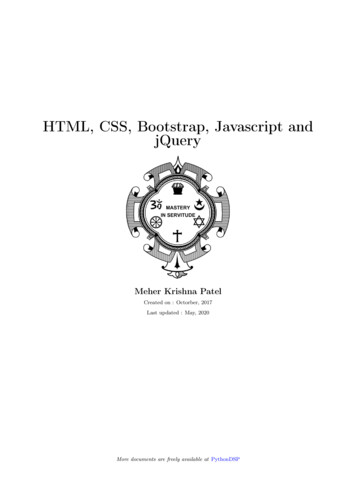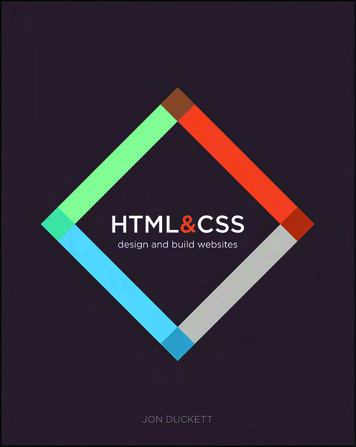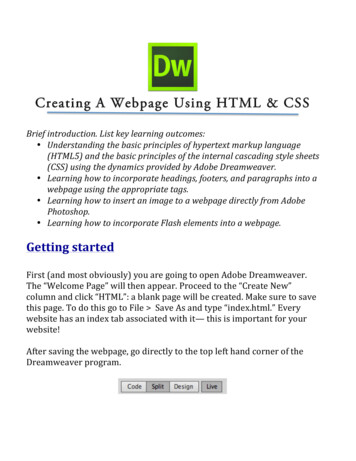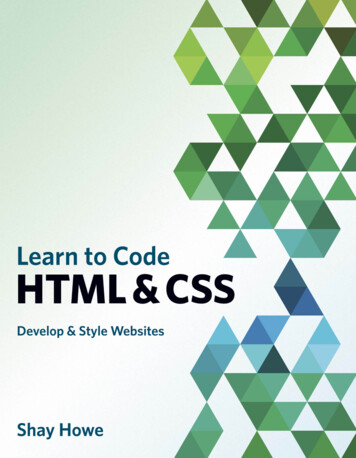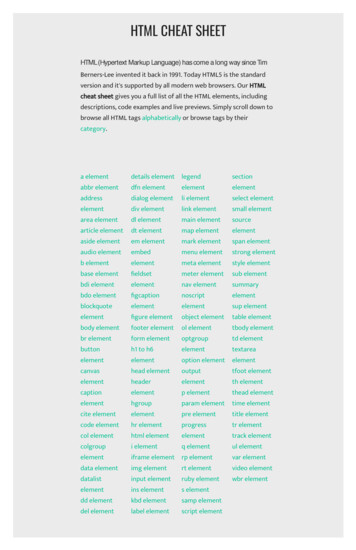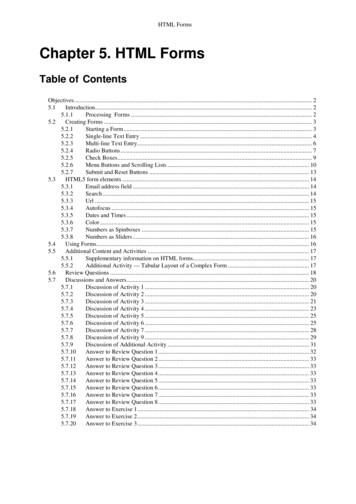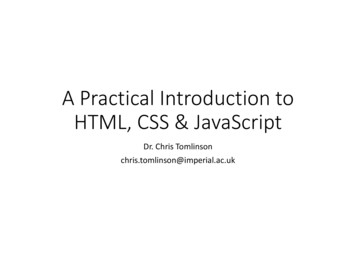
Transcription
A Practical Introduction toHTML, CSS & JavaScriptDr. Chris Tomlinsonchris.tomlinson@imperial.ac.uk
Outline Introduction HTML JavaScript, from static to dynamic CSS – a brief introduction http://dataman.bioinformatics.ic.ac.uk/computer skills
The Internet : What is happening?Request (URL)URL is decodedand the request issent to the correctwebserverResponse is a text stream in theform of a html document html . /html The web browser interprets thehtml and displays itWeb Server
HTML Documents HTML is the language of the web (Hyper Text Markup Language) Every internet browser can interpret and display HTML documents In reality HTML is just a stream of text that is formatted and displayed foryou on the screen by the web browser HTML documents consist of a series of pairs of tags often with text and othertags in between the tags A tag pair has an opening tag and a closing tag HTML tags are contained within (chevrons) An opening tag is like this html A closing tag is like this /html Tags should match (generally) HTML documents can be written in files with the postfix ‘.html’ i.e. page1.html
HTML Code Visit a web page that you like Right click on the page Select the ‘View Source’ option This is what the web server sends back to the browser The browser interprets and displays it
HTML Example Page 1 ! doctype html html head title First web page /title /head body My First web page /body /html
Other HTML Tags Hyperlink tag; a href "target url" Link Text /a Headings h1 Big Heading /h1 h2 Smaller Heading /h2 h3 Even Smaller Heading /h3 Text p Paragraph /p b Bold /b i Italic /i u underline /u br/ newline tag hr/ horizontal rule (line) across page
Exercise 1: Your First Web Page Make a new folder in your file system called web files or something like Make sure that file extensions are displayed so that they can be changed to .html In windows; Control Panel- Appearance and Personalisation- Folder Options Then un tick ‘Hide extensions for known file types’ Make a new text file in the directory called page1 Change the file extension so that it is called page1.html
Make the page below in your file using thehtml tags we have just seen Make the link go to the following web er skills) Visualise the page by opening it in a web browser Internet Explorer : File- Open Chrome : You can type the path in the address bar (file://C:/html/page1.html)
HTML Tables Tables are a very useful way of visualising information Tables have rows and columns The tags are; table /table : outer table tags th /th : table header row (for the first row of a table only) tr /tr : for a normal table row td /td for a table element
A Very Simple Table !DOCTYPE html html head meta charset "ISO-8859-1" title My First Table /title /head body table border 1 tr th Column 1 Head /th th Column 2 Head /th /tr tr td Column 1 Row 1 Data /td td Column 2 Row 1 Data /td /tr tr td Column 1 Row 2 Data /td td Column 2 Row 2 Data /td /tr /table /body /html
Exercise 2: Your HTML Page with a table Using the same data model as from the MySQL Lecture Practicalmake a page to represent a subject’s information inside a table. (first name, last name,gender, dob, smoker, drinker, study #) Make the page title the Subject’s nameHave a heading on the page of the subject’s name (inside h1 tags)Put a table in it to contain the subject’s attributesTable should have 7 rows and 2 columnsMake up data to go in the cells
Exercise 2
Sending Information via the Web To develop an interactive web application a web page has to be ableto send information to a webserver
HTML Forms Information can be sent back to the server via web forms Web forms consist of web page components that capture information
Form Tag All components in a form are contained within the FORM /FORM tag. The opening form tag will usually look something like this; form action "hospitals.html" method "POST" The action attribute is the address of the web page where information is sent The method attribute is the type of request that is sent to the server, POST isalmost always used with forms
Common Form Elements – Inside the form /form tagsText Text Input input type "text" name "username" id "username" value "ctomlins"/ Password Input input type "password" name "pass" id "pass"value "mypasswd" / Text Area textarea id "textareainput" name "textareainput" rows "5"cols "30" Text inside the text area goes between the tags /textarea "
Login Form FORM ACTION login.html METHOD POST TR TD Username /TD TD INPUT NAME "username" ID "username" TYPE "EDIT" SIZE 50 MAXLENGTH 50 VALUE "" /TD /TR TR TD Password /TD TD INPUT NAME "password" ID "password" TYPE "PASSWORD" SIZE 50 MAXLENGTH 50 VALUE "" /TD /TR TR TD Submit /TD TD INPUT NAME "submit" TYPE "SUBMIT" VALUE "Log in" /TD /TR /FORM
Form Elements – SelectorsPull Down List SELECT NAME team id ID team id OPTION VALUE 1 Alvin and the Chipmunks /OPTION OPTION VALUE 2 Fantastic Five /OPTION OPTION VALUE 3 Serious Quiz Leaders /OPTION /SELECT
Form Elements : Radio Buttons INPUT NAME "qChoice" id "qChoice 1" TYPE "RADIO" VALUE "true" INPUT NAME "qChoice" id "qChoice 2" TYPE "RADIO" VALUE "false"
Form Elements : Checkbox input id "molec conf 1" name "molec conf 1" type "CHECKBOX" value "1" checked input id "molec conf 2" name "molec conf 2" type "CHECKBOX" value "1"
Form Elements : Submit Button Pressing the submit button on a web form sends the information in itto the server The http address that the information is sent to is taken from theACTION attribute of the form tag
Form Elements : Submit Button FORM ACTION login.html METHOD POST TR TD WIDTH 25% ALIGN left VALIGN top BGCOLOR #ffffff COLSPAN 1 Username /TD TD WIDTH 75% ALIGN left VALIGN top BGCOLOR #ffffff COLSPAN 1 INPUT NAME "username" ID "username" TYPE "EDIT" SIZE 50 MAXLENGTH 50 VALUE "" /TD /TR TR TD WIDTH 25% ALIGN left VALIGN top BGCOLOR #ffffff COLSPAN 1 Password /TD TD WIDTH 75% ALIGN left VALIGN top BGCOLOR #ffffff COLSPAN 1 INPUT NAME "password" ID "password" TYPE "PASSWORD" SIZE 50 MAXLENGTH 50 VALUE "" /TD /TR TR TD WIDTH 25% ALIGN left VALIGN top BGCOLOR #ffffff COLSPAN 1 Submit /TD TD WIDTH 75% ALIGN left VALIGN top BGCOLOR #ffffff COLSPAN 1 INPUT NAME "submit" TYPE "SUBMIT" VALUE "Log in" /TD /TR /FORM
Exercise 3: Make a Web Form Make a new page that contains a Web Form formatted using a htmltable. The table should have 7 rows and 2 Columns. In the first columnshould be the name of the item and in the second column the formcomponent. The form will be for collecting information about patientsand should contain the following items; Make form method POST, set ACTION https://dataman.bioinformatics.ic.ac.uk/computer skills/quizzer/subject.html First name, Last Name (set id and name attributes first name, last name) Male or Female (radio buttons, id and name gender, values Male 1 Female 0) Smoker (check box, id and name ‘smoker’, value 1) Drinker (check box, id and name ‘drinker’, value 1) Experimental Study (id and name study id pull down menu with 5 optionsStudy 1 5, value 1 5) A submit button
HTML Summary HTML is a syntax for formatting internet content Page content is placed inside nested html tags that containformatting information for the browser Html forms allow a developer to make interactive web content, withinformation being sent back to the web server
Quiz followed by break
HTML Page StructureDocument Object Model (DOM)
Javascript Javascript is a language which enables you to put client side code intoyour web pages. This is used to make your web pages more interactive. The syntax of javascript is similar to Java but it is not really an OOlanguage Javascript commands are often triggered by event listeners on pagecomponents
Calling Javascript from your page You can call scripts on your page when certain things happen. Some html components have an onMouseOver eventlistener built in. ! doctype html html head title First Javascript page /title /head body A HREF "#" onMouseOver "document.bgColor 'black'" Black /a A HREF "#" onMouseOver "document.bgColor 'green'" Green /a A HREF "#" onMouseOver "document.bgColor 'yellow'" Yellow /a A HREF "#" onMouseOver "document.bgColor 'red'" Red /a A HREF "#" onMouseOver "document.bgColor 'brown'" Brown /a A HREF "#" onMouseOver "document.bgColor 'white'" White /a /body /html
Exercise 4: Add Javascript to your web form With your form page from Exercise 3, add an onClick attribute to thebutton tag. The attribute should say; ONCLICK "return confirm(‘Submit’);" This will make a Yes/No dialog box popup when the button ispressed. The form will only be submitted if Yes is clicked (i.e. true isreturned);
More Complex Javascript : Exercise 5 A script (inside a webpage) is a small program containing commands embeddedinside the html that makes up the page A script can have functions and variables like any program but can also operateon items within the web page A script can be also inserted inside a page using the SCRIPT . /SCRIPT tag. Many web page components have event listeners attached to them like theonClick and onMouseOver examples we have just seen. Scripts can be put in the head or body of a page or can be included from anexternal file Scripts usually contain functions that are triggered by the html event listeners. Put the script below into your form page and trigger myFunction(); when thestudy id pull down is changed (use the ‘ONCHANGE ‘ event listener) script type "text/javascript" function myFunction(){alert("Hello World");} /script
Javascript variable declaration Variables are not typed in Javascript and are declared using the varkeyword;var pi 3.142;var str "A text string";var obj;All of the above are valid variable declarations Strings are concatenated with the operator var str3 "any string :: " str;
More HTML : the div tag The div tag is used to define divisions or sections in a web page They are often used in conjunction with JavaScript and/or CascadingStyle Sheets (css) For instance the following div style "color:#0000FF" h3 This is a heading /h3 p This is a paragraph. /p /div will output the text inside the div in blue (by evaluating the styleattribute)
div : more info In order to make a link between a div tag and JavaScript (or css) thediv tag needs to be given an id div id "myDiv" . /div You can then reference the div in your JavaScript This way of referencing page components by ID is also valid for allother elements in the Document Object Model (i.e. anything that isin your web page)
JQuery Library There are many prewritten JavaScript libraries that you can use toincrease the power of the base JavaScript language One of the most popular ones is called JQuery and today it is widelyused Download the JQuery library from the course site and store in thesame directory as the web pages we have made
JQuery reference page component var div element (“#myDiv"); The JavaScript statement above returns a reference to the element inthe HTML document with the id myDiv Once you have a handle to the element you can then manipulate it JavaScript IS CASE SENSITIVE ! doctype html html head title JQuery Example /title script src "jquery.js" /script /head body div id "notMe" style "font: 15px arial, sans-serif;" p Div statement id "notMe" /p /div div id "myDiv" style "font: 15px arial, sans-serif;" p second div statement id "myDiv" /div script var div element (“#myDiv");div element.css( "border", "3px dotted red" );div element css("font-size", "27px"); /script /body
Javascript if statement//gender1 is a checkboxif( ("#gender1").is(":checked") ){ .}else{ }
Manipulate Page Data on the Fly : Exercise 6 chris.tomlinson@imperial.ac.uk Example of changing page content from Javascript;var div element (“#myDiv");div element.html("Change text between div tags of myDiv to this“); Using the page that you have developed with a web form on it (exercise 3); Include the jquery library in the head section of the code Remove form tag from your code In the HTML code insert a div tag below the web form and give it an ID Insert a new javascript function into your code that will be triggered when the form Submit button is pressed(onClick ‘myFunction();’ ). In the script declare a variable called str that will contain the output. Use alert to display the contents of str whiledeveloping (alert(str);) Get references to the form elements into variables jquery (“#.”) notation; Build up the string using the following; (“#input1”).val() – will give you the value of a text input called input1use ("#gender1").is(":checked") to find out if a checkbox / radiobutton is checked (in this case id is gender1)Use ("#study").children("option:selected").text(); to get the value of the pull down menu (if the pulldown has the id study) ("#displayDetails").html(str); : use this to set the inner text of the div
Client Side Validation of Form Data Exercise 6 showed how form data can be accessed from JavaScriptand processed Techniques like this are often used for client side form validation As your validation is exposed in the html document data should also bevalidated when sent back to the server
AJAX : Demonstration JavaScript is also used in lots of other ways AJAX stands for Asychronous JavaScript And XML AJAX enables you to communicate with a server in an asynchronous way (i.e.JavaScript can send requests to the server in response to GUI actions ratherthan when the page is loaded) One of the great things about JQuery is that it has an AJAX API built in Look at the AJAX Demonstration at; http://glycosciences.med.ic.ac.uk/structures.html
JavaScript and JQuery We have looked at some very simple JavaScripts today briefly usingJQuery JavaScript allows you to insert programs into your web pages so thatyou can make the pages interactive JavaScripts are often (but not always) triggered by GUI functions JQuery is a JavaScript library that is widely used to constructsophisticated JavaScript interfaces. My advice is, ALWAYS USE the JQuery library for JavaScriptimplementations It simplifies the access of page elements and AJAX implementation Libraries like d3 are built on top of JQuery - demonstration
Quiz Part II : Then Short Break
Cascading Style Sheets (css) css was introduced as a way of separating web page presentationfrom the logic of the page css directives define the look and feel of a web page and are solely todo with presentation css commands can be applied to a page in three ways; In line as a part of HTML tags Inside a page defined inside a style /style tag In a separate file that a web page accesses
css syntaxp {color:red;text-align:center;}HTML tagpropertyvalue/*This is a comment*/p{text-align:center;/*This is another comment*/color:black;font-family:arial;}
Inline CSS Inside a tag the style property is added and cssdirectives are added inside quotes The format of the css is property : value More than one css property can be separated by asemicolon We have already seen an example of this; div style "color:#0000FF" h3 This is a heading /h3 p This is a paragraph. /p /div Text within the div will be displayed in blue
Css: Using a Style Tag !doctype html html head style type "text/css" h2 {color: purple;} /style /head body h2 title 2 h2 p Lorem ipsum dolor sit amet, consectetur adipisicing elit,sed do eiusmod tempor incididunt ut labore et doloremagna aliqua. Ut enim ad minim veniam, quis nostrudexercitation ullamco laboris nisi ut aliquip ex ea commodoconsequat. Duis aute irure dolor in reprehenderit involuptate velit esse cillum dolore eu fugiat nulla pariatur.Excepteur sint occaecat cupidatat non proident, sunt inculpa qui officia deserunt mollit anim id est laborum.
Css : Using an included File It is a good idea to completely separate the css from the HTML byputting the css code in a separate file.
Course Web Page
Course web page Header HTML HEAD TITLE Computer Skills for Bioinformatics /TITLE LINK media allhref "https://dataman.bioinformatics.ic.ac.uk/computer skills/css/style.css"type text/css rel stylesheet /HEAD
Exercise 7 : Apply css styling to your form Download the style.css file from the web and store it in the samedirectory as your form https://dataman.bioinformatics.ic.ac.uk/computer skills/css/style.css Have a look at the file and the css directives in it Apply it to your web form (exercise 3) by copying the link line in the headsection from the java course html into your webform html head section Then put your form inside a div tag like this; div id container Your form html /div
Css : apply a style to an id In the css file you will have seen many items like this;#content {MARGIN-LEFT: 180px; WIDTH: 720px; MARGIN-RIGHT: 100px} This will apply the css to the section of the html with the idcontent div id "content" elements in here have css style content applied tothem /div
css : apply style to an id (2) This code in the style.css file will apply the css to elementswithin the P /P tags within a div with the id footer#footer P {PADDING-RIGHT: 5px; PADDING-LEFT: 5px; PADDING-BOTTOM: 5px; COLOR: #000077; PADDING-TOP: 5px; FONT-SIZE:12px; MARGIN: 0px auto; WIDTH: 1200px; COLOR: #666; LINE-HEIGHT: 1.6em; FONT-FAMILY: Lucida Grande, Tahoma, Arial, Helvetica,sans-serif;} Exercise 8 Modify the js function from exercise 6 so that it returns a string inside p tags inside a div with the id ‘footer’. Include the css file in the header
css : apply a style to more than one element The values of id attributes have to be unique by their nature If you want to apply a style to more than one element then you canuse the class attribute of a tag div class "data-table" /div table class "data-table" /table
css : apply style using class These correspond to the .data-table directives at the bottom of thecss file; So whenever data-table is included as a class attribute the css rulesare applied This can be applied to many elements on a page
Exercise 9 : Apply a CSS class to your formtable Apply the data-table rules to the table containing the form (exercise3) by including class "data-table" in the table tag
Working with multiple devices : BootstrapBootstrap provides some powerful web css/JavaScript templatesthat are designed to work on mobile devices seamlesslyhttp://getbootstrap.com/Demonstration
css QuizThe End
Javascript Javascript is a language which enables you to put client side code into your web pages. This is used to make your web pages more interactive. The syntax of javascript is similar to Java but it is not really an OO language Javascript commands




